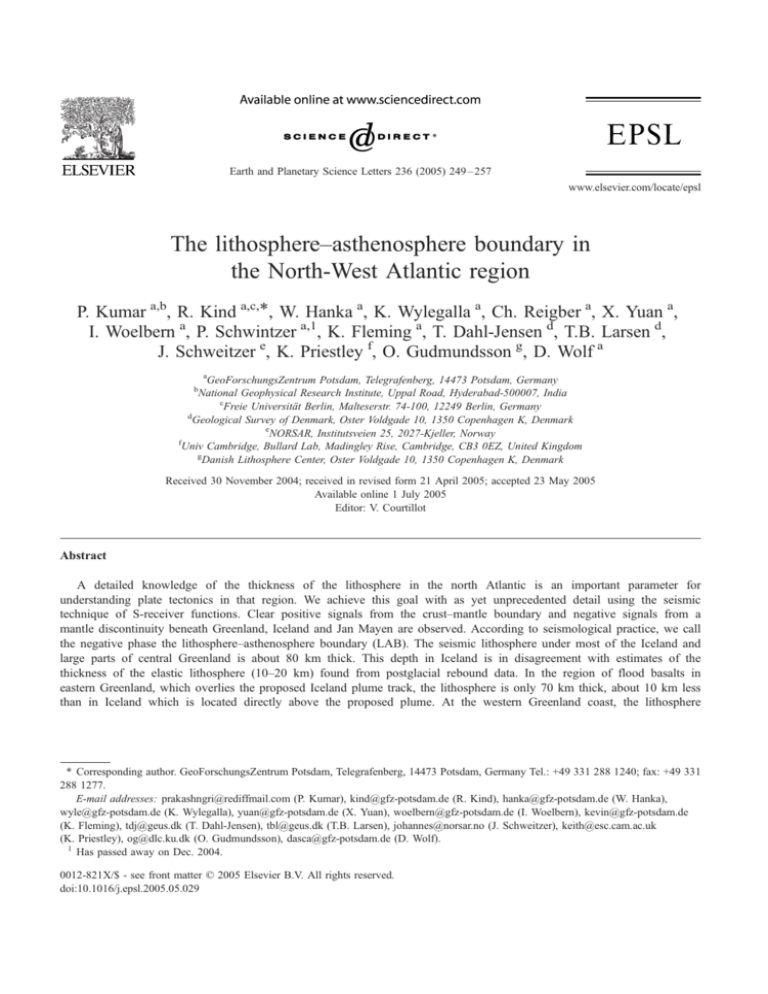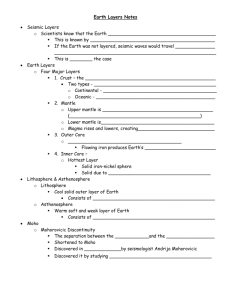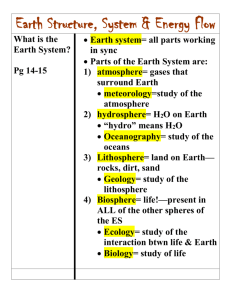
Earth and Planetary Science Letters 236 (2005) 249 – 257
www.elsevier.com/locate/epsl
The lithosphere–asthenosphere boundary in
the North-West Atlantic region
P. Kumar a,b, R. Kind a,c,*, W. Hanka a, K. Wylegalla a, Ch. Reigber a, X. Yuan a,
I. Woelbern a, P. Schwintzer a,1, K. Fleming a, T. Dahl-Jensen d, T.B. Larsen d,
J. Schweitzer e, K. Priestley f, O. Gudmundsson g, D. Wolf a
a
GeoForschungsZentrum Potsdam, Telegrafenberg, 14473 Potsdam, Germany
National Geophysical Research Institute, Uppal Road, Hyderabad-500007, India
c
Freie Universität Berlin, Malteserstr. 74-100, 12249 Berlin, Germany
d
Geological Survey of Denmark, Oster Voldgade 10, 1350 Copenhagen K, Denmark
e
NORSAR, Institutsveien 25, 2027-Kjeller, Norway
f
Univ Cambridge, Bullard Lab, Madingley Rise, Cambridge, CB3 0EZ, United Kingdom
g
Danish Lithosphere Center, Oster Voldgade 10, 1350 Copenhagen K, Denmark
b
Received 30 November 2004; received in revised form 21 April 2005; accepted 23 May 2005
Available online 1 July 2005
Editor: V. Courtillot
Abstract
A detailed knowledge of the thickness of the lithosphere in the north Atlantic is an important parameter for
understanding plate tectonics in that region. We achieve this goal with as yet unprecedented detail using the seismic
technique of S-receiver functions. Clear positive signals from the crust–mantle boundary and negative signals from a
mantle discontinuity beneath Greenland, Iceland and Jan Mayen are observed. According to seismological practice, we call
the negative phase the lithosphere–asthenosphere boundary (LAB). The seismic lithosphere under most of the Iceland and
large parts of central Greenland is about 80 km thick. This depth in Iceland is in disagreement with estimates of the
thickness of the elastic lithosphere (10–20 km) found from postglacial rebound data. In the region of flood basalts in
eastern Greenland, which overlies the proposed Iceland plume track, the lithosphere is only 70 km thick, about 10 km less
than in Iceland which is located directly above the proposed plume. At the western Greenland coast, the lithosphere
* Corresponding author. GeoForschungsZentrum Potsdam, Telegrafenberg, 14473 Potsdam, Germany Tel.: +49 331 288 1240; fax: +49 331
288 1277.
E-mail addresses: prakashngri@rediffmail.com (P. Kumar), kind@gfz-potsdam.de (R. Kind), hanka@gfz-potsdam.de (W. Hanka),
wyle@gfz-potsdam.de (K. Wylegalla), yuan@gfz-potsdam.de (X. Yuan), woelbern@gfz-potsdam.de (I. Woelbern), kevin@gfz-potsdam.de
(K. Fleming), tdj@geus.dk (T. Dahl-Jensen), tbl@geus.dk (T.B. Larsen), johannes@norsar.no (J. Schweitzer), keith@esc.cam.ac.uk
(K. Priestley), og@dlc.ku.dk (O. Gudmundsson), dasca@gfz-potsdam.de (D. Wolf).
1
Has passed away on Dec. 2004.
0012-821X/$ - see front matter D 2005 Elsevier B.V. All rights reserved.
doi:10.1016/j.epsl.2005.05.029
250
P. Kumar et al. / Earth and Planetary Science Letters 236 (2005) 249–257
thickens to 100–120 km, with no indication of the Iceland plume track identified. Below Jan Mayen the lithospheric
thickness varies between 40 and 60 km.
D 2005 Elsevier B.V. All rights reserved.
Keywords: Lithosphere–asthenosphere boundary; Iceland; Greenland; S-receiver functions
1. Introduction
High-viscosity lithospheric plates moving over a
lower-viscosity asthenosphere is a basic element of
plate tectonics. Lithosphere and asthenosphere are
originally mechanical definitions with regards to
their reaction to forces acting over thousands or
millions of years [1]. However, additional usages of
the term dlithosphereT have been introduced since
then: thermal, seismic or chemical [2]. Obtaining
high-resolution seismic observations of the lithosphere–asthenosphere boundary (LAB) is not an
easy task. Observations of low seismic velocities in
the upper mantle are interpreted as being indicative of
the asthenosphere. The first seismic observations of an
dasthenospheric channelT were obtained by Gutenberg
[3] at about 100 km depth. Therefore, seismologists
sometimes call the LAB the dGutenberg discontinuityT
(mostly in oceanic regions). The lithosphere is seismologically divided into two parts, the crust and the
mantle lithosphere, the latter being the high-velocity
lid on top of the asthenosphere. However, high-resolution seismic body-wave observations of the LAB are
very rare. This is in contrast to the Moho, which is
globally a much better documented discontinuity. So
far, most information about the thickness of the lithosphere comes from low-resolution surface-wave
observations (e.g. [4]). The thickness of the lithosphere is considered to be close to zero at midocean ridges, about 200 km beneath stable cratons,
with 80–100 km being the global average. Thybo and
Perchuc [5] suggest the existence of a global zone of
reduced velocity at about 100 km depth underlying
continental regions, based on controlled source seismic data. Li et al. [6] and Kumar et al. [7] obtained
detailed maps of the LAB around the Hawaiian island
chain and in the Tien Shan–Karakoram region, respectively, using the S-receiver function technique [8].
This new technique complements the traditional S to
P conversion method (applied to S or SKS phases)
and adds a few more processing steps. Such steps are,
as in the P-receiver function technique, source equalisation by deconvolution and distance move-out correction. Both steps are applied in order to enable the
summation of events from different distances and with
different magnitudes and source-time functions. This
technique works very well, enabling observations of
the LAB with a resolution so far only known for the
Moho.
In this work we determine the lithospheric thickness for Iceland, Greenland and the island of Jan
Mayen. Greenland is a continent of Precambrian age
(see [9] for a discussion of Greenland geology).
Darbyshire et al. [10] observed a thickening of the
lithosphere from 120 to 200 km going from east to
west in southern Greenland using the surface wave
technique.
Iceland is thought to be one of the classic mantle
plumes [11] interacting with a mid-ocean ridge, although this view is disputed [12]. The crustal thickness (up to 45 km) is several times thicker than that
expected for oceanic crust (e.g. [13,14]). White and
McKenzie [15] concluded that the large thickness of
the Icelandic crust is a result of magmatic intrusions.
The mechanical lithosphere of Iceland is thought to be
very thin (10–20 km), judging from rapid postglacial
uplift [16]. A 10–20 km thick lithosphere would mean
that the lower crust and Moho are located within the
asthenosphere. There are also arguments that east
Iceland may be a continental splinter [17–19]. Seismic
surface-wave studies have furthermore found indications of a 50–110 km thick lithosphere under parts of
Iceland [18,20,21]. Evans and Sacks [22] found between Iceland and Jan Mayen a lithospheric thickness
of 50 km from surface wave data, typical for young
oceans. Vinnik et al. [23] have shown a negative
discontinuity at a depth of 80 km beneath all of Iceland, using essentially the same data and technique
that we have used here. Jan Mayen is a small volcanic
island located about 600 km north of Iceland and
P. Kumar et al. / Earth and Planetary Science Letters 236 (2005) 249–257
about 400 km east of Greenland on the Jan Mayen
fracture zone. It is considered to be a micro continent
[24].
251
a
BRE
HOT15
66˚
HOT09
HOT08
KLU
HOT04
2. Data and observations
HOT12
HOT07
HOT06
HOT27
HOT05
HOT03
BLOL
HOT26
HOT25
NYD
ASKJ
BORG
80
II
ALE
DAG
DBG
UPN
NGR
A
SUM
GDH
˚
NUK
B
F
HJO
IS2
SOE
SFJ
60
DY2
D
BIRH
HOT24
HOT23
HOT19
HOFF
LJOP
KAF
HOT21
HOT22
-25˚
68˚
-20˚
-15˚
b
4
7
1
66˚
2
64˚
8
5
3
6
62˚
-25˚
-20˚
-15˚
-10˚
E
C
70
˚
64˚
HOT18
Fig. 2. a) Location of the temporary seismic stations of the HOTSPOT and ICEMELT experiments and of the IRIS station BORG. b)
Location of the piercing points of the S receiver functions at 80 km
depth. Also marked are the regions (1–8) used for the summation of
the seismic traces.
I
˚
HOT30
HOT16
ASBS
HOT17
HOT14 SKOT
HOT02
For the Greenland study, we used seismic data
from the GLATIS and NEAT experiments [25,26].
During these experiments, seismic stations were
deployed along the Greenland coast and on the ice
sheet for periods ranging from several months to
several years. For Iceland, we used the publicly available data of the ICEMELT and HOTSPOT experiments [27,28]. In addition, we used data from
permanent IRIS [29] and GEOFON [30] stations,
and from two seismic stations on the island of Jan
Mayen: JMI, operated by the Norwegian National
Seismic Network (http://www.Ifjf.uib.no/Seismologi/
nnsn/nsninfo2.html) and JMIC, operated by NORSAR [31]. The locations of the stations and of the
S-P piercing points at 80 km depth are shown in
Figs. 1–3. Since converted phases are usually weak
signals, a number of records must be summed to
obtain a good signal-to-noise ratio. We defined nonoverlapping regions on Greenland, Iceland and Jan
HOT29
HOT13
ANG
0˚
G
PAA
-60
˚
-20
˚
-40˚
Fig. 1. Location of the temporary and permanent seismic stations of
the GLATIS and NEAT experiments, and of IRIS and GEOFON in
Greenland (and one in NE Canada, ALE) used in this study (reversed triangles), and of the piercing points of the S-receiver functions at 80 km depth (plus signs). The regions used for the
summation of seismic traces have also been marked and are labelled
A–F and I, II.
Mayen, where all traces with piercing points in
these regions have been summed to form one record
that is representative for the entire region (see Figs.
1–3). The number of traces stacked within each
region are more than 20 (see Figs. 1, 2, and 3a).
Individual traces (not summed traces) are shown in
Fig. 3b for the Jan Mayen stations as an example of
the quality of our data. The individual S-receiver
functions and its stacks are also shown from the
region 2 in Iceland (Fig. 4a), and from the region C
in Greenland (Fig. 4b).
Fig. 5a shows the summation traces of the P
component for all regions. Zero time is the S-arrival
time, where negative times indicate the period prior to
the S arrival. We have rotated the ZNE components
into the RTZ system using the theoretical backazi-
P. Kumar et al. / Earth and Planetary Science Letters 236 (2005) 249–257
-20˚
0˚
-10˚
-30˚
252
a
68˚
71.5˚
9A
64˚
71˚
JMIC
JMI
9B
-10˚
-9˚
70.5˚
-7˚
-8˚
Backazimuth (deg.)
Time (s)
b
0
8
22
24
24
25 26
32
63 68
75 138 237 340
-5
LAB
-10
-15
18
24
24
25
26
9A
29
33
63
75
86 138 278 353
9B
Fig. 3. a) Location of the seismic stations JMI and JMIC of the Norwegian National Seismic Network (JMI) and of NRSAR (JMIC) on the
island of Jan Mayen and of the piercing points of the S-receiver functions used. Also marked are two regions, 9A and 9B, that were used for the
summation of seismic traces. b) Individual (not summed) S receiver functions observed at the Jan Mayen stations. The LAB is clearly observed
in all traces. Events with backazimuths of 8–258(region 9A) show the LAB earlier then the events arriving from all other azimuths (region 9B).
Time (s)
a
0
SUM
Moho
-5
LAB
-10
-15
-20
Time (s)
b
0
-5
-10
SUM
Moho
LAB
-15
-20
Fig. 4. The individual S-receiver functions from Iceland and Greenland and the corresponding stacked traces on the left. (a) is from the
region 2 in Iceland (Fig. 2) and (b) is from the region C in Greenland (Fig. 1). These two plots clearly show the presence of coherent
negative phases at around 8 to 9 s. The small scatter in the data
(about 0.5 s) are a source of errors in depth determination.
muth angle. R and Z are then rotated a second time
into the P-SV system. The angle of incidence is
defined by the minimum of energy in the P component at the arrival time of the S phase. All traces are
distance moveout corrected before summation, using
a reference slowness of 6.4 s/deg based on the
IASP91 global reference model [32]. A bandpass
filter of 4–20 s has been applied. Two precursor
phases are clearly visible in Fig. 5a, the Moho and
a second phase, which we term the LAB. The arrival
times of the Moho and LAB must be measured at the
maximum (or minimum) of the signal due to the
deconvolution. The arrival times of the LAB in seconds may be multiplied by a factor of 10 (according
to the IASP91 model) to obtain the LAB depth estimate in kilometers. The possible sources of errors in
depth determination are primarily from the time to
depth conversion (due to the uncertainty in lithospheric velocity) and the selection of the times of the
P. Kumar et al. / Earth and Planetary Science Letters 236 (2005) 249–257
a
0
B II A 3 D C E G 2 5 6 8 1 7 4 F I 9B 9A
Time (s)
MOHO
-5
-10
LAB
-15
-20
Time (s)
b
0
MOHO
-5
-10
LAB
-15
-20
Depth (km)
c
0
MOHO
50
100
LAB
150
Fig. 5. a) S-receiver functions in the NW Atlantic obtained at
seismic stations on Greenland, Iceland and Jan Mayen. Zero is
the arrival time of the S phase. Negative times indicate the period
prior to the S-signal arrival. Characters on top of the figure indicate
the regions used for the summation of the seismic traces. The
location of these regions is shown in Fig. 2. Two seismic phases
are marked: the crust–mantle boundary (Moho) and the lithosphere–
asthenosphere boundary (LAB). The traces are sorted by the arrival
times of the LAB phase. The time scale is valid for a move out
correction slowness of 6.4 s/degree. Multiplication of the LAB
times by a factor of 10 gives approximately the LAB depth. b)
Theoretical receiver functions of the S velocity models in c). Moho
and LAB are the only two phases predicted by the model (no
multiples). The velocities are kept fixed in all models in c) (Vs
crust = 3.58 km/s, Vs lithospheric mantle lid = 4.5 km/s, Vs asthenosphere = 3.9 km/s). Only the depth of both the discontinuities are
varied to fit the travel times.
phases due to scattering (~0.5 s) in the data. Here, we
estimated the maximum error bounds due to the
various uncertainties as being less than about 10 km
for the depth estimation. The signs of the Moho and
the LAB are opposite, indicating downward increasing and decreasing velocity jumps, respectively. The
traces in Fig. 5a are sorted according to the arrival
times of the LAB. Characters on the top correspond to
the regions (see Figs. 1–3). The clearness of the LAB
253
in Fig. 5a is especially remarkable, since phases in the
uppermost mantle are difficult to observe at a high
resolution using other techniques. In P-receiver functions, the time window of the LAB arrival is heavily
disturbed by crustal reverberations. These reverberations are not present in the S-receiver functions,
because the converted phases are S precursors, whereas multiples arrive after the main phase. The Moho is
usually well observed in P-receiver functions, which
have shorter periods and therefore higher resolution.
Hence, we will concentrate here on the LAB phase. It
should be noted that stations on the Greenland Ice
Sheet (regions C and D) produce nearly undisturbed
S-receiver functions in contrast to P-receiver functions, which are heavily disturbed by reverberations
in the ice layer [25]. In Fig. 5b,c we have modelled
the observed data presented in Fig. 5a using theoretical seismograms (Fig. 5b), the models used are displayed in Fig. 5c. Complete theoretical seismograms
are computed (plane-wave Haskell-matrix formalism)
using simple models consisting of a homogeneous
crust on top of a homogeneous mantle lithosphere,
both overlaying a homogeneous asthenosphere.
However, we have not modelled the sharpness of
the LAB. Only the depths of the Moho and of the
LAB have been adjusted to fit the different arrival
times of both phases in different regions. We believe
this simple modelling, which is sufficient to reproduce all features of the S precursors (in S-receiver
functions), provides evidence for the interpretation of
the observed phase called LAB as the lithosphere–
asthenosphere boundary.
A map of the LAB depth, as determined from the
data, is shown in Fig. 6. The LAB is 80 km deep
under most of Iceland and large parts of Greenland
(yellow in Fig. 6). In Iceland, we have only two
regions where the LAB differs from 80 km depth,
region 3 (90 km, light blue) and region 4 (70 km,
light red). Along the west coast of Greenland, the
LAB is at 100–120 km depth (dark blue). North of
Greenland, in the transition to the Arctic Ocean, the
LAB shallows from 120 km (dark blue) to 70 km
(light red). The shallowest LAB on Greenland is
observed in region F (70 km, light red). The Jan
Mayen LAB varies between 40 and 60 km depth
(dark red) and is clearly the shallowest observed in
this study. Details of the Jan Mayen LAB are given
in Fig. 3b. A surprising result is that the entire
254
P. Kumar et al. / Earth and Planetary Science Letters 236 (2005) 249–257
km
80
˚
100
I
D
e
80 p
t
h
60
II
Greenland
E
C
70
˚
9A,B
A
F
D
60
˚
120
G
B
-60˚
40
Jan Mayen
1 4 7
2 5 8
3 6 Iceland
0˚
-20˚
-40˚
Fig. 6. Bathymetric map of the NW Atlantic with regions marked
where the depth of the lithosphere was obtained by the S-receiver
functions. Location of seismic stations and of piercing points of S
receiver functions at the LAB are shown in Figs. 1–3.
Icelandic LAB has practically the same depth as
large parts of central Greenland.
limit of 1 1019 Pa s for the underlying viscosity.
Sigmundsson and Einarsson [33], from an assessment
of lake-tilt data resulting from the melting of the
Vatnajoekull Ice Cap, inferred a sub-lithosphere viscosity of between 1 1018 5 1019 Pa s. More recently, Thoma and Wolf [34] used present-day
changes in uplift and gravity to propose thicknesses
of 10 to 20 km for the lithosphere, and a viscosity
range of 7 1016 3 1018 Pa s for the asthenosphere
viscosity. Similar values are given by Sjoeberg et al.
[35], based on GPS campaign results from around
Vatnajoekull. The result of a 50–100 km thick seismic
lithosphere beneath Iceland, as seen in seismic surface-wave data and in S-receiver function data, therefore appears to conflict with these estimates of the
elastic lithosphere thickness (10–20 km). To examine
how we may reconcile the two estimates, Fig. 7 presents predictions of vertical uplift rates around Vatnajoekull based on a range of earth models that
a
Depth (km)
0
10
20
30
40
50
60
70
80
3. Discussion and conclusions
Low-viscosity channel ηlvc = 1018 Pa s
Elastic
Low-viscosity zone ηlvz = 1018 Pa s
b
Vertical-displacement rate (mm yr-1)
Similar to our results, Li et al. [6] and Kumar et al.
[7] have also observed the LAB in Hawaii and in the
Tien Shan–Karakoram area, respectively. These findings lead us to suppose that the LAB may be a
globally existing and observable discontinuity, comparable to the Moho. The S-receiver function technique therefore appears to be a very useful tool for
mapping the global LAB.
However, as mentioned above, there are different
usages of the phrase dlithosphereT. In seismology, a
velocity decrease marks the lower boundary of the
lithosphere, whereas the mechanical thickness of the
lithosphere may be estimated from other data, such as
postglacial rebound observations. In Iceland, these
data sets give different results. Glacial-isostatic adjustment (GIA) studies infer that the viscosity stratification underlying Iceland consists of a thin elastic
lithosphere overlying a low-viscosity asthenosphere.
For example, Sigmundsson [16], using post-glacial
sea-level observations and assuming a 10 km elastic
lithosphere (the approximate maximum depth of
earthquakes in SW-Iceland), estimated an upper
Model 1 Model 2 Model 3 Model 4 Model 5 Model 6 Model 7 Model 8
30
Model 1
Model 5
Model 2
Model 6
Model 3
Model 7
Model 4
Model 8
Sjöpberg et al. (2004)
25
20
15
10
5
0
-5
-10
0
20
40
60
80
100 120
Distance from ice-cap centre (km)
140
Fig. 7. a) The earth models used to examine the possibility that the
80 km discontinuity represents a lower elastic layer bounding a lowviscosity channel. b) The predicted and measured [38] vertical uplift
rates from the centre of the Vatnajoekull Ice Cap.
P. Kumar et al. / Earth and Planetary Science Letters 236 (2005) 249–257
incorporate a low-viscosity channel within the seismic
lithosphere, as well as earth-model end members with
lithosphere thicknesses of 80 and 10 km. Although a
detailed parameter space study was not carried out,
our assumed viscosity (1018 Pa s) is of a similar order
of magnitude as values found from other studies (e.g.
0.3–2 1019 Pa s [36], 1992; 3 1018 3 1019 Pa s
[37]). These results are compared with recent GPSbased up-lift rates [38]. Model 6, with a channel
thickness of 50 km, gives a reasonable fit to the
observations. However, an alternative explanation of
this discrepancy may be that the seismic lithosphere,
reacting to short term (seconds or minutes) elastic
forces, is not related to the elastic lithosphere reacting
to longer term (years to thousands of years) forces.
a
70
40
0
b
Time (s)
0
-5
A
-10
-5
D
C
0
5
F
10
1
m
5
255
The suggested track of the Iceland plume in Greenland is marked by tertiary flood basalts in our regions
F and A (Fig. 6, [9,39]). The lithosphere in region F is
the thinnest for Greenland (70 km) while region A,
which is located at the west coast, shows a lithosphere
thickness of about 120 km (Fig. 6). This could mean
that the track of the Iceland plume is traceable to the
east coast of Greenland, but not to the central part or
the west coast, where the lithosphere has possibly had
enough time to regain its normal thickness. This could
also mean that the Iceland plume has caused, in a
manner similar to the Hawaii plume, a delayed rejuvenation of the lithosphere (starting from our observed 80 km lithosphere at Iceland) when the plate
passed over it. In Fig. 8, the residual geoid signal in
the NW-Atlantic is shown, obtained from a combination of the most recent CHAMP [40]and GRACE [41]
satellite data with aerogravimetry and terrestrial gravity data from the Arctic Gravity Project (ArcGP, [42])
after all geoid features larger than 2500 km were
filtered out. We note positive residual geoid heights
over the Iceland hotspot as well as in our region F at
the east coast of Greenland. There is no continuation
of these positive residual heights across Greenland to
the flood basalt region at the west coast (region A).
The larger positive anomaly in southern Greenland
remains unexplained. The thinning of the lithosphere
in eastern Greenland (region F in Fig. 8b) is clearly
visible. The thinning occurs in the mantle part of the
lithosphere, not in the crust, because the Moho in
region F is not updoming.
8
MOHO
-10
LAB
-15
-20
Fig. 8. a) Residual geoid signal in the NW Atlantic region, obtained
from a combination of CHAMP and GRACE satellite and aerogravimetry/terrestrial gravity data (after removal of all geoid components N2500 km). The suggested trace of the Iceland plume is
marked (dashed line, [43]). The numbers give the estimated time of
the plume location in millions years BP. The white encircled regions
near the plume track mark Tertiary flood basalts in eastern and
western Greenland. b) S-receiver functions from Fig. 5a aligned
along the plume trace. The characters on the top of the figure mark
the regions described in Figs. 1, 2, and 3a.
Acknowledgements
This research was supported by the GFZ Potsdam,
the Deutsche Forschungsgemeinschaft (DFG) and the
European Commission (EC). PK was supported by a
stipend from the Deutsche Akademische Austauschdienst (DAAD). PK is also grateful to the Director,
NGRI and DG, CSIR, India, for granting him leave to
carry out this research work. Some of the seismic
stations were provided by the station pool of the
GFZ Potsdam, data is stored in the GEOFON archive.
We thank Joachim Saul, Franz Barthelmes and Neil
Mcglashan for their support. R.K.’s research visit at
NORSAR was supported by the EC Programme Access to Research Infrastructures (Contract HPRI-CT-
256
P. Kumar et al. / Earth and Planetary Science Letters 236 (2005) 249–257
2002-00189). We also wish to thank Bob Trumbull for
discussions. Reviews by two anonymous reviewers
and G. R. Foulger improved the manuscripts. The
computations have been done in SeismicHandler (K.
Stammler).
References
[1] J. Barrell, The strength of the Earth’s crust, J. Geol. 22 (1914)
680ff.
[2] D.L. Anderson, Lithosphere, asthenosphere, and perisphere,
Rev. Geophys. 33 (1995) 125 – 149.
[3] B. Gutenberg, Untersuchungen zur Frage bis zu welcher Tiefe
die Erde kristallin ist, Z. Geophys. 2 (1926) 24 – 29.
[4] J. Dormann, M. Ewing, J. Oliver, Study of shear-wave velocity
distribution in the upper mantle by mantle Rayleigh waves,
Bull. Seismol. Soc. Am. 50 (1960) 87 – 115.
[5] H. Thybo, E. Perchuc, The seismic 88 discontinuity and
partial melting in the continental mantle, Science 275
(1997) 1626 – 1629.
[6] X. Li, R. Kind, X. Yuan, I. Woelbern, W. Hanka, Rejuvenation
of the lithosphere by the Hawaiian plume, Nature 427 (2004)
827 – 829.
[7] P. Kumar, X. Yuan, R. Kind, G. Kosarev, The lithosphere–
asthenosphere boundary in the Tien Shan–Karakoram region
from S receiver functions: evidence for continental subduction,
Geophys. J. Lett. 32 (2005), doi:10.1029/2004GL022291.
[8] V. Farra, L.P. Vinnik, Upper mantle stratification by P and S
receiver functions, Geophys. J. Int. 141 (2000) 699 – 712.
[9] N. Henriksen, A.K. Higgins, F. Kalsbeek, T.C.R. Pulvertaft,
Greenland from archean to quarternary, Geol. Greenl. Surv.
Bull. 185 (2000).
[10] F.A. Darbyshire, T.B. Larsen, K. Mosegaard, T. Dahl-Jensen,
O. Gudmundsson, T. Bach, S. Gregersen, H. Pedersen, W.
Hanka, A first detailed look at the Greenland lithosphere and
upper mantle, using Rayleigh wave tomography, Geophys. J.
Int. 158 (2004) 267 – 286.
[11] W.J. Morgan, Convection plumes in the lower mantle, Nature
230 (1971) 42 – 43.
[12] D.L. Anderson, Thermal state of the upper mantle; no role for
mantle plume, Geophys. Res. Lett. 27 (2000) 3623 – 3626.
[13] F.A. Darbyshire, I.T. Bjarnason, R.S. White, O.G. Flovenz,
Crustal structure above the Iceland mantle plume imaged by
the ICEMELT refraction profile, Geophys. J. Int. 135 (1998)
1131 – 1149.
[14] M.A. Allen, G. Nolet, W.J. Morgan, K. Vogfjord, M. Nettles,
G. Ekstrom, B.H. Bergsson, P. Erlendsson, G.R. Foulger, S.
Jakobsdottir, B.R. Julian, M. Pritchard, S. Ragnarson, R.
Stefanson, Plume driven plumbing and crustal formation in
Iceland, J. Geophys. Res. 107 (B8) (2002) 2163, doi:10.1029/
2001JB000584.
[15] R. White, D. McKenzie, Magmatism at rift zones: the generation of volcanic continental margins and flood basalts, J.
Geophys. Res. 94 (1989) 7685 – 7729.
[16] F. Sigmundsson, Post-glacial rebound and asthenosphere
viscosity in Iceland, Geophys. Res. Lett. 18 (1991)
1131 – 1134.
[17] H.E.F. Amundsen, et al., in: B. Jamtveit, H.E.F. Amundsen
(Eds.), 15th Kongsberg Seminar, Norway, Kongsberg, 2002.
[18] I.T. Bjarnason, The Lithosphere and Asthenosphere of the
Iceland Hot Spot, IUGG, 2003.
[19] T. Fedorova, W.R. Jacoby, H. Wallner, Crust–mantle transition
and Moho model for Iceland and surroundings from seismic,
topography, and gravity data, Tectonophysics 396 (2005)
119 – 140.
[20] I.T. Bjarnason, How thick is the lithosphere below Iceland?
How large is the velocity inversion and what does it mean?
(Abstract), EOS Trans. AGU 80 (46) (1999) F645 (Fall Meet.
Suppl.).
[21] A. Li, R.S. Detrick, Structure of crust and upper mantle
beneath Iceland from Rayleigh wave tomography (Abstract),
EOS Trans. AGU 84 (46) (2003) F645 (Fall Meet. Suppl.).
[22] J.R. Evans, I.S. Sacks, Deep structure of the Iceland plateau,
J. Geophys. Res. 84 (1979) 6859 – 6866.
[23] L.P. Vinnik, G.R. Foulger, Z. Du, Seismic boundaries in the
mantle beneath Iceland: a new constraint on temperature,
Geophys. J. Int. 160 (2005) 533 – 538.
[24] S. Kodaira, R. Mjelde, K. Gunnarsson, H. Shiobara, H.
Shimamura, Structure of Jan Mayen microcontinent and
implication for its evolution, Geophys. J. Int. 132 (1998)
383 – 400.
[25] T. Dahl-Jensen, T.B. Larsen, I. Woelbern, T. Bach, W. Hanka,
R. Kind, S. Gregersen, K. Mosegaard, P. Voss, O. Gudmundsson, Depth to Moho in Greenland: receiver function analysis
suggests two proterozoic blocks in Greenland, Earth Planet.
Sci. Lett. 205 (2003) 379 – 393.
[26] S. Pilidou, K. Priestley, E. Debayle, O. Gudmundsson, Rayleigh wave tomography in the North Atlantic: high resolution
images of the Iceland, Azores and Eifel mantle plumes,
LITHOS 79 (2005) 453 – 474.
[27] I.T. Bjarnason, C.J. Wolfe, S.C. Solomon, G. Gudmundson,
Initial results from the ICEMELT experiment: body-wave
delay times and shear-wave splitting across Iceland, Geophys.
Res. Lett. 23 (1996) 459 – 462, doi:10.1029/96GL00420.
[28] G.R. Foulger, M.J. Pritchard, B.R. Julian, J.R. Evans, R.M.
Allen, G. Nolet, W.J. Morgan, B.H. Bergsson, P. Erlendsson,
S. Jakobsdottir, S. Ragnarsson, R. Stefansson, K. Vogfjord,
The seismic anomaly beneath Iceland extends down to the
mantle transition zone and no deeper, Geophys. J. Int. 142
(2000) F1 – F5.
[29] R. Butler, T. Lay, K. Creager, P. Earl, K. Fischer, J. Gaherty, G.
Laske, B. Leith, J. Park, M. Ritzwoller, J. Tromp, L. Wen, The
global seismographic network surpasses its design goals, EOS
Trans. AGU 80 (23) (2004) 225 – 229.
[30] W. Hanka, A. Heinloo, K.-H. Jaeckel, Networked seismographs: GEOPHONE real time data distribution, ORFEUS
Electron. Newsl. 2 (2000) 24 (http://orfeus.knmi.nl/newsletter/
vol2no3/heofon.html).
[31] J. Fyen, K. Iranpour, Near real time data at NORSAR for
CTBT monitoring, ORFEUS Electron. Newsl. 5 (2) (2003)
(http://orfeus.knmi.nl/newsletter/vol5no2/norsar.html).
P. Kumar et al. / Earth and Planetary Science Letters 236 (2005) 249–257
[32] B.L.N. Kennett, E.R. Engdahl, Traveltimes for global earthquake location and phase identification, Geophys. J. Int. 105
(1991) 429 – 465.
[33] F. Sigmundsson, P. Einarsson, Glacial-isostatic crustal movements caused by historical volume change of the Vatnajoekull
ice cap Iceland, Geophys. Res. Lett. 19 (1992) 2123 – 2126.
[34] M. Thoma, D. Wolf, Inverting uplift near Vatnajoekull, Iceland, in terms of lithosphere thickness and viscosity stratification, in: M. Sideris (Ed.), Gravity, Geoid and Geodynamics,
Springer-Verlag, Berlin, 2001, pp. 97 – 102.
[35] L. Sjoeberg, M. Pan, E. Asenjo, S. Erlingsson, Glacial rebound
near Vatnajoekull, Iceland, studied by GPS campaigns in 1992
and 1996, J. Geodyn. 29 (2000) 63 – 70.
[36] G.R. Foulger, C.-H. Jahn, G. Seeber, P. Einarsson, B.R. Julian,
K. Heki, Post-rifting stress relaxation at the divergent plate
boundary in Iceland, Nature 358 (1992) 488 – 490.
[37] F.F. Pollitz, I.S. Sachs, Viscosity structure beneath northeast
Iceland, J. Geophys. Res. 101 (1996) 17771 – 17779.
[38] L.E. Sjoeberg, M. Pan, S. Erlingsson, E. Asenjo, K. Arnason, Land uplift near Vatnajoekull, Iceland, as observed by
GPS in 1992, 1996 and 1999, Geophys. J. Int. 159 (2004)
943 – 948.
257
[39] M. Storey, A.K. Pedersen, O. Stecher, S. Bernstein, H.C.
Larsen, L.M. Larsen, J.A. Baker, R.A. Duncan, Long-lived
postbreakup magmatism along the east Greenland margin:
evidence from shallow-mantle metasomatism by the Iceland
plume, Geology 32 (2004) 173 – 176, doi:10.1130/G19889.1.
[40] C. Reigber, H. Jochmann, J. Wünsch, S. Petrovic, P. Schwintzer, F. Barthelmes, K.-H. Neumayer, R. König, C. Förste, G.
Balmino, R. Biancale, J.-M. Lemoine, S. Loyer, F. Perosanz,
Earth gravity field and seasonal variability from CHAMP, in:
C. Reigber, H. Lühr, P. Schwintzer, J. Wickert (Eds.), Earth
Observation with CHAMP—Results from Three Years in
Orbit, Springer-Verlag, Berlin, 2004, pp. 25 – 30.
[41] C. Reigber, R. Schmidt, F. Flechtner, R. König, U. Meyer,
K.-H. Neumayer, P. Schwintzer, S.Y. Zhu, An Earth gravity
field model complete to degree and order 150 from GRACE:
EIGEN-GRACE02S, J. Geodyn. 39 (2005) 1 – 10.
[42] R.S. Forsberg, Kenyon, Gravity and geoid in the Arctic
region—The northern gap now filled, Proc. of 2nd GOCE
User Workshop (on CD-ROM), ESA SP-569, ESA Publication Division, 2004.
[43] L.A. Lawver, R.D. Müller, Iceland hotspot track, Geology 22
(1994) 311 – 314.









